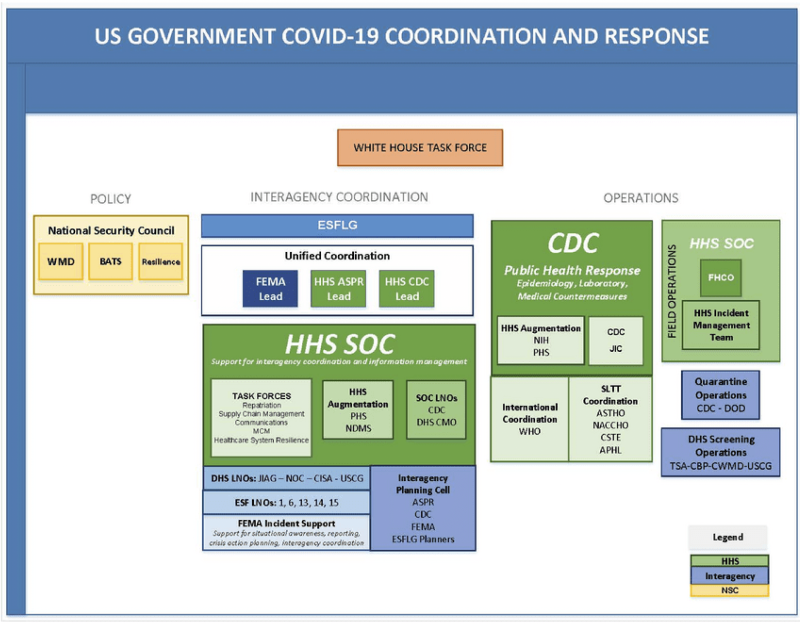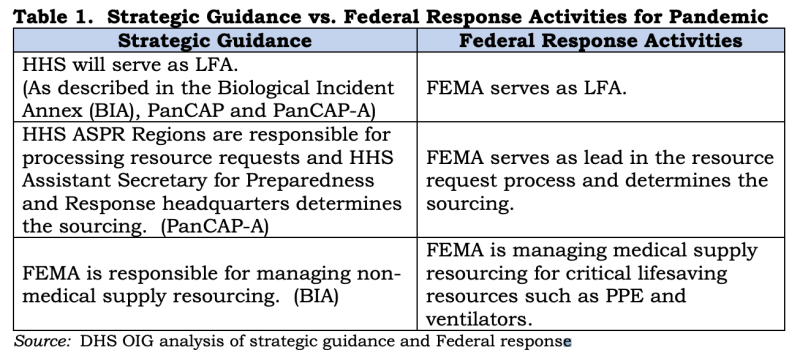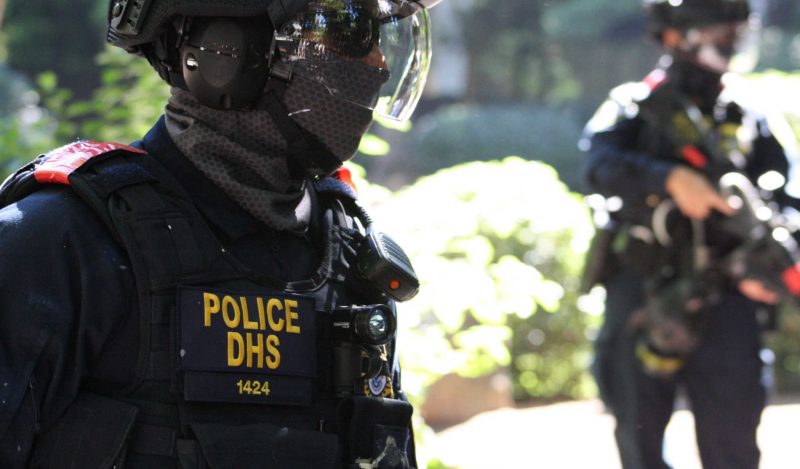In previous articles I discussed the probability that Deborah Birx, the White House Coronoavirus Task Force Coordinator, was not a representative of the public health agencies but, rather, was appointed by the National Security Council. I now have proof that this was, indeed, the case. I have also uncovered documents that show:
- As of March 13, 2020 the National Security Council (NSC) was officially in charge of the US government’s Covid policy.
- Starting on March 18, 2020, The Federal Emergency Management Agency (FEMA), under the Department of Homeland Security (DHS), was officially in charge of the US government’s Covid response.
The Covid Task Force Coordinator was brought in by the NSC
On March 11, 2020, at a Heritage Foundation Talk, Trump’s National Security Advisor, Robert O’Brien, when discussing what the White House and NSC were doing about the virus, said:
“We brought into the White House Debi Birx, a fantastic physician and ambassador from the State Department. We appreciate Secretary Pompeo immediately moving her over to the White House at our, well at the President’s, request.” (min. 21:43 – 21:56)
The National Security Council was in charge of our Covid Policy
An astonishing government document dated March 13, 2020 entitled: “PanCAP Adapted U.S. Government COVID-19 Response Plan” (PanCAP-A) (embedded at the end of this piece) reveals that United States policy in response to SARS-CoV-2 was set not by the public health agencies designated in pandemic preparedness protocols (Pandemic and All Hazards Preparedness Act, PPD-44, BIA), but rather by the National Security Council, or NSC.
This is the pandemic response org chart, from p. 9 of PanCAP-A, showing the NSC solely responsible for Covid policy:


What is the National Security Council?
According to its website, the NSC “is the President’s principal forum for considering national security and foreign policy matters with his or her senior advisors and cabinet officials.”
The NSC does not include as regular attendees any representatives from public health-related agencies.
It does include the President’s National Security Advisor, who is “the President’s most important source of policy advice on foreign and national security policy,” according to the White House Transition Project’s document for The National Security Advisor and Staff. “In some administrations,” the document continues, “foreign and national security policy making is essentially centralized in the hands of the NSC advisor with minimal input from cabinet-level departments such as State or Defense.” Furthermore, “there is little statutory or legal constraint (beyond budgetary limits) in how the role of NSC advisor is defined or how the NSC staff is organized and operates.” (pp. 1-2)
In other words, if the NSC is in charge of Covid response, it can pretty much decide and impose anything it wants without any constraints or oversight, as long as the President agrees, or at least lets them take the lead.
But what exactly is PanCAP-A, in which the NSC appears in such a surprising Covid-response leadership role?
PanCAP-A is the closest we have to a national Covid response plan
PanCAP-A stands for Pandemic Crisis Action Plan – Adapted.
An exhaustive online search did not turn up the Pandemic Crisis Action Plan from 2018, which was apparently “adapted” to produce PanCAP-A. However, the existence of the original document is confirmed in various documents, including a statement on “Preparedness for COVID-19” presented to the US Senate Committee on Homeland Security and Government Affairs on April 14, 2021.
In this statement, Elizabeth Zimmerman, a former FEMA Administrator, who is sharing with the Senate Committee her findings on “The Initial Pandemic Response and Lessons Learned,” says she had trouble finding the government’s plan for the US response to Covid-19:
“In researching disaster response plans to refresh my memory for this hearing, I found several detailed plans that were publicly available and saw mention of plans and directives that were not publicly available. The time spent searching for these plans and directives was frustrating for an experienced emergency manager…”
Then, in reference to the plans she was able to find, or knew about but may not have actually seen, she says:
“Following the Anthrax attacks in 2001, the federal government invested a lot of money on processes and plans centered on public health response – bioterrorism and pandemics in particular. … One of the latest plans, January 2017, is the Biological Incident Annex (BIA) to the Response and Recovery Federal Interagency Operational Plans (FIOPs). The BIA is the federal organizing framework for responding and recovering from a range of biological threats, including pandemics.
However, it was not publicly seen that these plans were being used during the onset of COVID-19 nor does it seem that there was a national COVID-19 response plan.
Finally, she references the 2018 PanCAP, the adapted PanCAP, and then makes another surprising statement:
Also, there was a 2018 Pandemic Crisis Action Plan (PanCAP) that was customized for COVID-19 specifically and adopted in March 2020 by HHS and FEMA; the plan identified the U.S. Department of Health and Human Services (HHS) as the Lead Federal Agency (LFA) with FEMA supporting for coordination. However, a mere five days after the national COVID-19 emergency was announced, FEMA became the LFA.” [BOLDFACE ADDED]
FEMA replaced HHS as the Lead Federal Agency, with no warning or preparation
What Zimmerman is saying here is that, in the PanCAP-A org chart, where the NSC is in charge of policy and the HHS is in charge of almost everything else – actually, FEMA is in charge of everything else.
This means that, in effect, starting on March 18, 2020, the HHS –which comprises the CDC, NIAID, NIH and other public-health-related agencies – had NO OFFICIAL LEADERSHIP ROLE in pandemic response – not in determining policy and not in implementing policy.
This is a staggering piece of information, considering that all pandemic preparedness plans, as Zimmerman notes, placed the Health and Human Services Agency (HHS) at the helm of pandemic response.
How was FEMA put in charge?
According to the Stafford Act, which “constitutes the statutory authority for most Federal disaster response activities especially as they pertain to FEMA and FEMA programs,” the disasters to which FEMA is empowered to respond include:
“any natural catastrophe (including any hurricane, tornado, storm, high water, winddriven water, tidal wave, tsunami, earthquake, volcanic eruption, landslide, mudslide, snowstorm, or drought), or, regardless of cause, any fire, flood, or explosion, in any part of the United States, which in the determination of the President causes damage of sufficient severity and magnitude to warrant major disaster assistance under this Act to supplement the efforts and available resources of States, local governments, and disaster relief organizations in alleviating the damage, loss, hardship, or suffering caused thereby.”
Very clearly, FEMA is an agency neither designed nor intended to lead public health initiatives or the country’s response to disease outbreaks.
Yet, as Zimmerman reported, on March 18, 2020, just five days after the official date of PanCAP-A, the Department of Health and Human Services (HHS) was removed from its lead role in pandemic response, and FEMA was (at least operationally if not policy-wise) put in charge.
In a Congressional Research Service report from February 2022, entitled “FEMA’s Role in the COVID-19 Federal Pandemic Response,” the opening paragraph states:
“On March 13, 2020, President Donald J. Trump declared a nationwide emergency under the Robert T. Stafford Disaster Relief and Emergency Assistance Act (the Stafford Act, P.L. 93-288 as amended), authorizing assistance administered by the Federal Emergency Management Agency (FEMA). Five days later, the President notified then-FEMA Administrator Peter Gaynor that the agency would assume leadership of the federal pandemic response effort—the first known instance of FEMA serving in such a role for a public health incident.”
FEMA’s January 2021 COVID-19 Initial Assessment Report emphasizes how unusual this chain of events was:
“The agency’s response to COVID-19 has been unprecedented. When the White House directed FEMA to lead operations, COVID-19 became the first national pandemic response that FEMA has led since the agency was established in 1979. It was also the first time in U.S. history the President has declared a nationwide emergency under Section 501b of the Stafford Act and authorized Major Disaster Declarations for all states and territories for the same incident.” (p. 5)
A FEMA fact sheet from March 4, 2020 reveals that the agency was not given advanced warning of the enormous new responsibilities that would be thrust upon it just two weeks later:
“At this time, FEMA is not preparing an emergency declaration in addition to the Public Health Emergency declared by HHS on January 31, 2020.” (p. 2)
The table below is from a September 2021 report from the Office of Inspector General (OIG) of the Department of Homeland Security, “Lessons Learned from FEMA’s Initial Response to COVID-19.” This document stresses that “The PanCAP-A did not address the changes that ensued when FEMA was designated the LFA. Furthermore, FEMA (and HHS) did not update the PanCAP-A or issue interim guidance addressing the changes in critical roles and responsibilities for each agency.” (p. 11)


In other words, HHS – the agency designated by statute and experience to handle public health crises – was removed, and FEMA – the agency designated by statute and experience to “help people before, during and after disasters” like earthquakes and fires – was put in charge. But the pandemic planning document was not updated to reflect that change or how that change would affect the Covid response.
Why was FEMA suddenly and unexpectedly given this lead role? I would argue that the NSC wanted to ensure that no policy or response initiative emanating from the public health departments would play any role in the Covid response. Since FEMA had no planning documents or policies regarding disease or pandemic outbreaks, there would be nothing in the way of whatever the NSC wanted to do.
So what did the NSC want to do? PanCAP-A, in which the NSC takes the lead role in setting Covid policy, does not give a detailed answer, but does clearly place NSC policy above anything else that might contradict it.
What does PanCAP-A say?
On p. 1, under “Purpose” it states:
“This plan outlines the United States Government (USG) coordinated federal response activities for COVID-19 in the United States (U.S.). The President appointed the Vice President to lead the USG effort with the Department of Health and Human Services (HHS) serving as the Lead Federal Agency (LFA) consistent with the Pandemic and All Hazards Preparedness Act (PAHPA) and Presidential Policy Directive (PPD) 44.”
In other words, in accordance with a bunch of pandemic preparedness laws and directives, the HHS is the Lead Federal Agency in charge of pandemic response.
As we move through the document, however, the roles and responsibilities of the HHS become increasingly muddled and diminished.
On p. 6 under “Senior Leader Intent” it says:
“The National Security Council (NSC) requested adaptation of the PanCAP to address the ongoing threat posed by COVID-19 in support of the Administration’s efforts to monitor, contain, and mitigate the spread of the virus. The plan builds on objectives that prepare the USG to implement broader community and healthcare-based mitigation measures…” [BOLDFACE ADDED]
In other words, everything the Pan-CAP-A says about how the HHS is planning to address the pandemic is “adapted” in favor of “objectives” that prepare the government to implement “broader measures.”
On the next page, we get the exact same vague language under “Strategic Objectives,” which include implementing “broader community and healthcare-based mitigation measures.” A footnote tells us “These objectives were directed by the NSC Resilience DRG PCC on February 24, 2020.” [BOLDFACE ADDED]
What is the NSC Resilience DRG PCC? There is no explanation, appendix, or addendum, nor anything in the entire PanCAP-A to answer this question – a noteworthy omission, since it apparently defines the objectives upon which the entire US pandemic response is based.
Similarly, on p. 8 under “Concept of Operations,” we read:
“This concept of operations aligns interagency triggers to the CDC intervals for each phase and groups key federal actions according to response phase. It also layers in the COVID-19 Containment and Mitigation Strategy developed by the NSC.” [BOLDFACE ADDED]
There is no explanation or description of what the “Containment and Mitigation Strategy developed by the NSC” is referring to.
Conclusion
Everything we thought we knew about the US government’s Covid response is upended in the Pandemic Crisis Action Plan – Adapted (PanCAP-A), which gave the NSC sole authority over policy, and the simultaneous Stafford Act declaration, which resulted in FEMA/DHS taking the lead role in its implementation.
This means the doctors on the White House Task Force who headed HHS departments – including Fauci, Redfield, and Collins, the heads of the CDC, NIAID and NIH – had no authority over determining or implementing Covid policy and were following the lead of the NSC and the DHS (Department of National Security), which is the department under which FEMA operates.
It means our response to the Covid pandemic was led by groups and agencies that are in the business of responding to wars and terrorist threats, not public health crises or disease outbreaks.
I believe that the national security authorities took control of the Covid pandemic response not just in the US but in many of our allied countries (the UK, Australia, Germany, Israel and others) because they knew SARS-CoV-2 was an engineered virus that leaked from a lab researching potential bioweapons.
Whether or not the “novel coronavirus” was in fact a highly lethal pathogen, it was a military threat because it was a potential bioweapon, and therefore it required a military-style response: strict lockdowns in anticipation of Warp Speed vaccine development.
Furthermore, all of the seemingly nonsensical and unscientific policies – including mask mandates, mass testing and quarantines, using case counts to determine severity – were imposed in the service of the singular goal of fomenting fear in order to induce public acquiescence with the lockdown-until-vaccines policy.
And once the national security authorities were in charge, the entire biodefense industrial complex, consisting of national security and intelligence operatives, propaganda/psy-op (psychological operations) departments, pharmaceutical companies and affiliated government officials and NGOs assumed leadership roles.
Much research is needed to unearth more evidence in support of these hypotheses. The work continues.
Join the conversation:


Published under a Creative Commons Attribution 4.0 International License
For reprints, please set the canonical link back to the original Brownstone Institute Article and Author.









